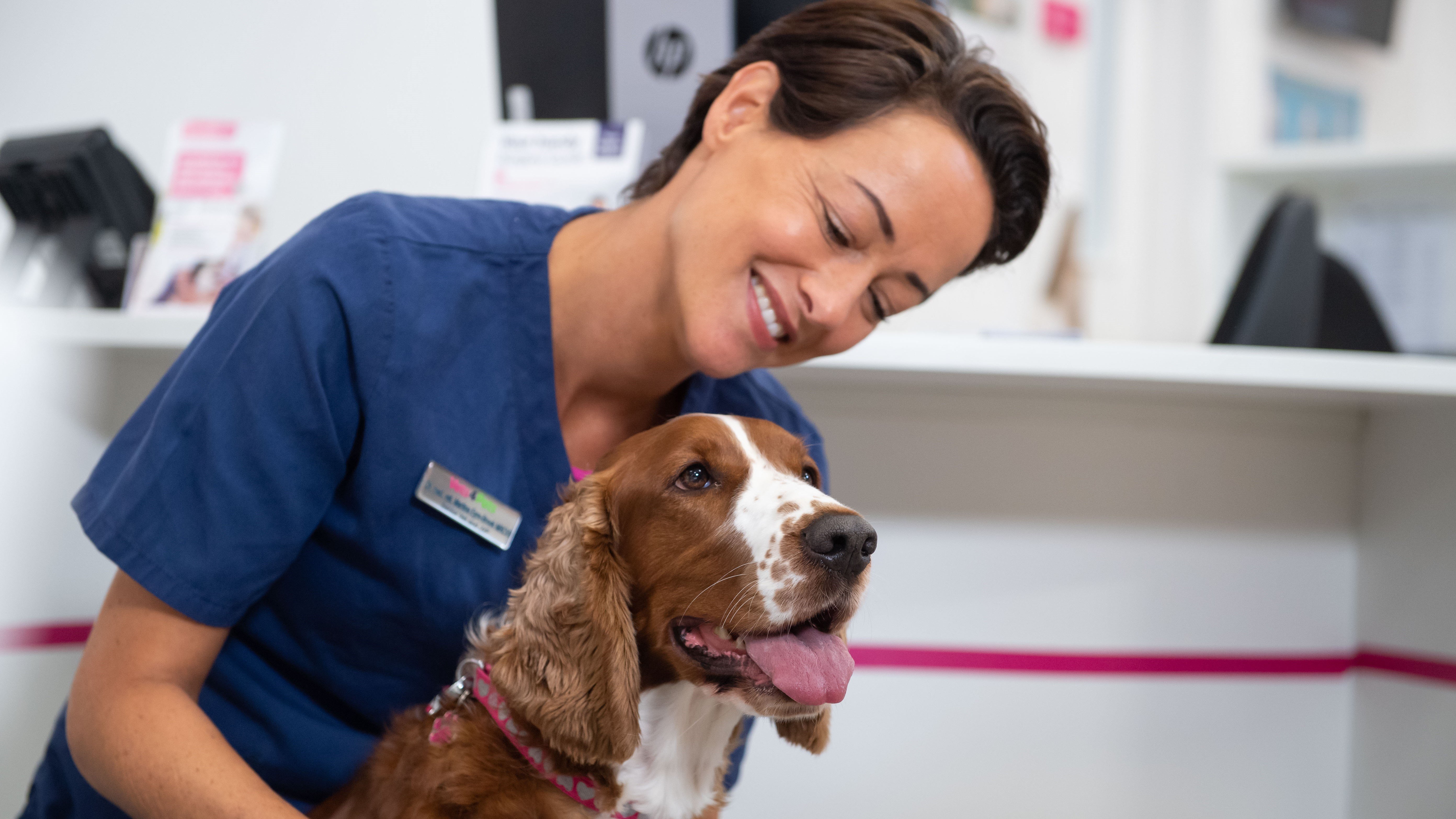
Dog flea treatment: How to protect dogs from fleas
Fleas are tiny parasites that love to feed on your pet’s blood. The bites cause irritation and this can effect you and your family as well.
Fleas are tiny parasites that love to feed on your pet’s blood. The bites cause irritation and this can effect you and your family as well.
These bites usually cause your pet to scratch, and it can lead to irritation and allergies. If fleas become established on your dog, it can lead to more serious health problems and you could end up with an infestation in your home.
More about fleas and your dog
Fleas are small, wingless insects that, despite their inability to fly, can travel huge distances by jumping. To survive fleas must feast on warm blood, and they aren’t fussy – most household pets can be bitten by fleas, and sadly humans are also at risk too.
Fleas reproduce really quickly, and live most of their life off their animal hosts. They actually reproduce much like butterflies but produce larvae instead of caterpillars.
As so much of the lifecycle happens off your pet controlling an infestation of fleas can be a difficult job.
- A female flea can lay up to 500 eggs in her lifetime! The eggs are small and white, and while they are often laid on the host, they aren't attached in any way. This means as your pet moves around your home the eggs will slide off, and get buried into carpet fibres, cracks in the floor, soft furnishings and pet bedding.
- Eggs will hatch into flea larvae within twelve days. Larvae do not feed on blood, and instead feed on organic debris in the home. They don't like the light, so tend to burrow deeper into wherever they are, which means you rarely see them.
- After approximately 1-3 weeks, larvae will spin themselves a cocoon and start to change into adult fleas. The developing larvae inside are called pupae and approximately 10% of the flea population in your home at any time will be pupae.
- It is the pupae that make fleas so difficult to eradicate. In favourable conditions, pupae will hatch into adult fleas within days to weeks, but in unfavourable conditions pupae can remain dormant in their cocoons for months! They are also sticky, so are hard to remove with light vacuuming or sweeping.
- When conditions are right an adult flea will emerge. They must locate a new host quickly, and feed, in order to start the life cycle again and lay their eggs.
There are a few signs that indicate your dog has fleas. These signs include:
Itching (your dog scratching, licking or biting at their skin)
If you have more than one dog, or any other furry pets in the home, you may see them itching. You may even be itching yourself, and see red bumps on your skin where fleas have bitten.
Flea dirt
Flea eggs are white and hard to spot, but flea dirt (a mixture of flea poo and dried blood) can often be seen on the skin of dogs who have fleas. This looks like little reddish brown specks, and can often be mistaken for grains of soil. You can test to see if specks on your dog’s coat are actual dirt or flea dirt using the wet paper test. Get some damp paper towel or cotton wool and gently wipe up some of the specks. If the area around the speck turns reddish-brown, it’s flea dirt.
Live fleas
You may be able to see live fleas in your dog’s coat if you part the fur or stroke them backwards. Fleas are very fast though, and can be difficult to spot! Around the base of the tail and on the tummy are good areas to look.
Hair loss and sores
If your dog is itching a lot, they may damage their skin, leading to sores developing and hair loss.
Tapeworms
If your dog has a tapeworm, it may have come from a flea. Tapeworms can survive inside fleas, and get transmitted into your dog if they accidentally consume the flea when licking their coat.
The best way to keep fleas at bay is to treat your dog regularly with a good quality flea treatment. There are a number of different options, but not all of them may be suitable for your dog, so you should check with your vet as they will be able to give you the most appropriate advice for your dog.
Although the summer is the most common time to see fleas, vets also see peaks in flea populations in winter, when central heating tends to warm up houses. This means that flea protection should be given year round, not just seasonally.
Your vet will help advise you on when to start flea treatment, but for most dogs, they'll receive their first treatment at around six to eight weeks old. The exact age will depend on the type of flea treatment chosen and the weight of your dog.
If you have an adult dog, you can start their flea treatment any time – just ask your friendly Vets4Pets team for advice and help. Don’t forget, if you don’t know the weight of your dog, your vets will always weigh your dog for free!
Flea protection comes in many forms including pills, spot-ons and collars. Weaker preparations and drugs are available in pet shops, but the most effective prescription flea protection can only be sourced via a vet. Many of the flea preparations your vet can offer will also cover your dog for a range of other parasites as well, giving you peace of mind.
Discussing flea protection with your local vet will help you make the right choice for you and your pet. Our Complete Care plan is a great way to provide comprehensive flea and worm protection for your dog, as well as other preventative healthcare, all for a handy monthly fee!
If your dog already has fleas, don’t panic! Although an infestation can take time to eradicate, your vet will help provide you with everything you need to get on top of fleas in your home.
The main points to remember to eradicate fleas from your home are:
- Treat all dogs and cats in the home with flea treatment. Check other furry family members carefully to check they are not also infested, and treat if required.
- Treat pets with flea treatment regularly going forward.
You can reduce the initial population of fleas by:
- Flea treatment for all pets.
- Flea-killing house spray (make sure to read to safety label).
- Carpet cleaning.
- Regular hoovering and sweeping, including in the darkest and hardest to reach areas. Don't forget to throw away the dust bag from your vacuum cleaner after every use, else the flea larvae may escape back out!
- Hot washing fabrics at over 60 degrees, as this will destroy any fleas.
By doing all the above you can dramatically reduce the number of fleas in your home. The flea treatment for your pets will turn them into walking ‘flea killers’ and means that adult fleas will die without producing any more eggs. By treating the house, you will kill or remove many of the eggs and pupae that can be found in the home.
Due to the flea lifecycle, and the pupae that lay dormant, ongoing treatment for your pets is really important. Despite your best efforts it is impossible to definitely kill or remove all flea pupae as there may be dormant pupae in the house, even after you eradicate them from your pet.
Although we are not sure exactly how long these pupae can lay dormant for, it may be as long as months. At any point a dormant pupa could hatch, and will look to your pet as a food source. If you have continued with comprehensive flea treatment for your dogs and cats, this newly hatched adult flea will die before laying any more eggs. Slowly, all dormant pupa will hatch, die or be removed, and your treated pets will prevent another infestation from developing. Your treated pets will also kill any new fleas that have been brought into the house, making sure that a new population cannot establish itself.
UK fleas are not very fussy, and are more than happy to bite an unsuspecting human which can make the skin itchy and sore.
Flea bites can also cause more than itchy skin. Bartonella (also called cat scratch disease) can be transmitted by flea faeces; either by being accidentally ingested, or by getting into small breaks in the skin. Causing a low grade fever and swelling of the lymph nodes, bartonella infection can often be mistaken for the flu, and in many cases resolves on its own. Sadly, however, in some people bartonella infection can develop and cause chronic fatigue and headaches, and may become very debilitating.
Speak to your GP if you have any concerns for your health.
Health Plans to keep your dog healthy
At Vets4Pets we offer a range of Health Plans that make essential routine treatments more affordable. You'll save money on things like annual vaccinations, flea and worm treatment and routine health check-ups.

Dog Advice
Read more of our expert dog advice to keep your dog happy and healthy.

